Standing Poses
Ashva Sanchalasana
Low Lunge
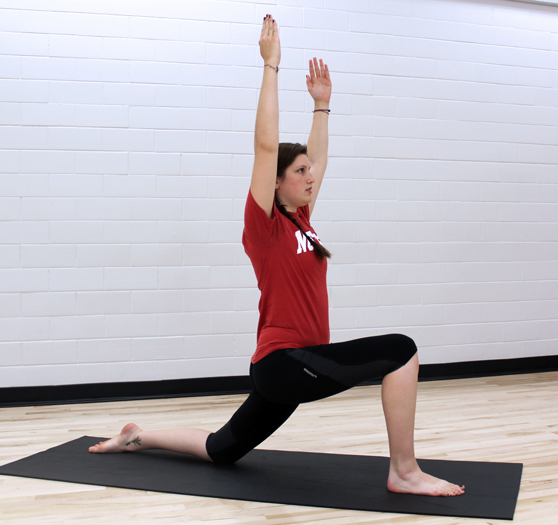
Alignment Cues:
- parallel leg alignment (“train track” legs)
- keep the front knee over the front ankle (do not allow it to travel forward)
- arms can reach overhead, rest on the front thigh, or take a variety of other positions
- engage lower abdominals (pulling in and up) to protect and lengthen the lumbar spine
Drishti: straight forward
Stretches: hip flexors of the back leg
Anjaneyasana
Crescent Lunge
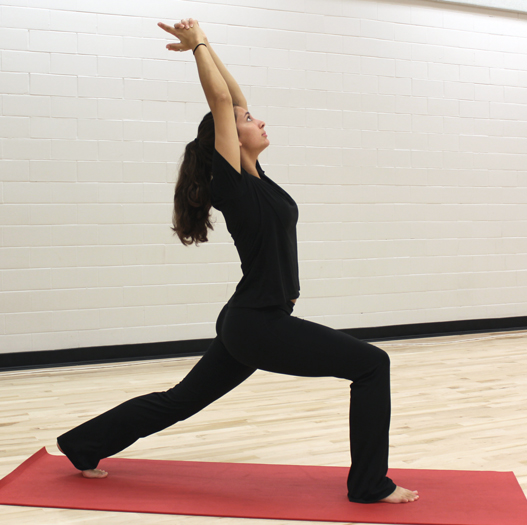
Alignment Cues:
- parallel leg alignment (“train track” legs)
- reaching towards a 90° bend in the front knee
- stretching the thoracic spine into extension (reaching the heart up towards the sky)
- arms squeeze in towards the ears and angle up and back to match the arc of the spine
- strongly engage the lower abdominals to lengthen and protect the lumbar spine
- Jupiter mudra is often utilized in this pose (shown in image)
Drishti: upward, towards the sky
Strengthens: legs, arms
Stretches: hip flexors of the back leg, thoracic spine
Ardha Uttanasana
Standing Half Forward Fold (Flat Back)
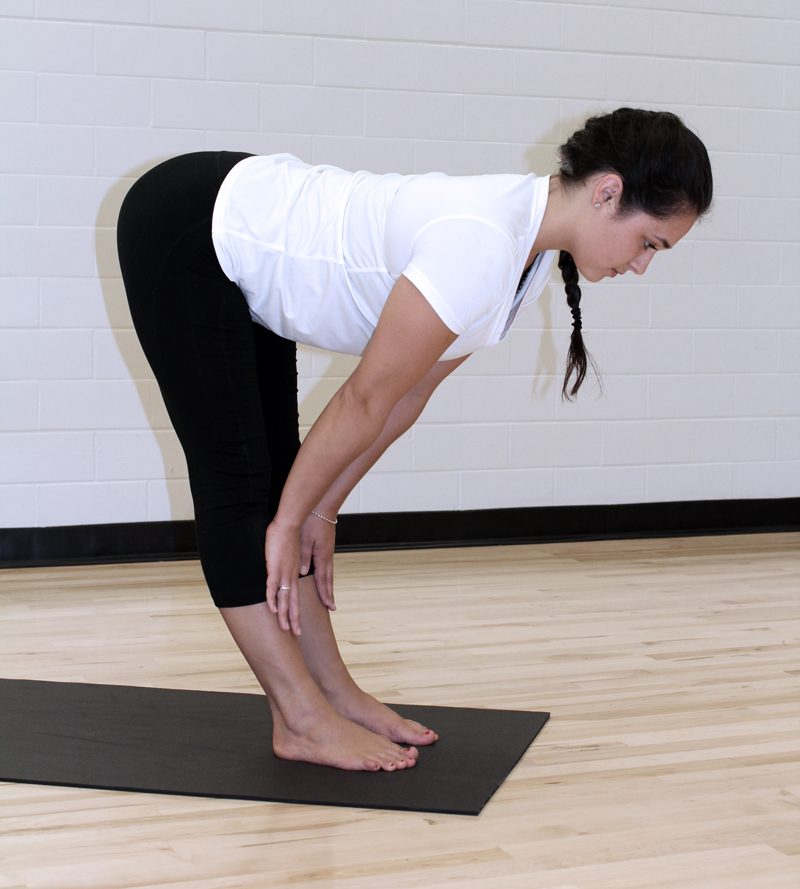
Alignment Cues:
- heels lined up directly under sitting bones
- feet pointing straight forward
- send weight into the balls of the feet to keep hips lined up over ankles (avoid “sitting back” in the hips)
- reach out through the top of the head to lengthen the spine
- pull the shoulder blades together to avoid “hunching” upward in the thoracic spine
- engage the lower abdominals to lengthen and protect the lumbar spine
- hands can reach up the legs or can press into a block
Drishti: downward, towards the floor so that the cervical spine stays lengthened
Strengthens & Stretches: hamstrings
Baddha Parsvakonasana
Bound Side Angle
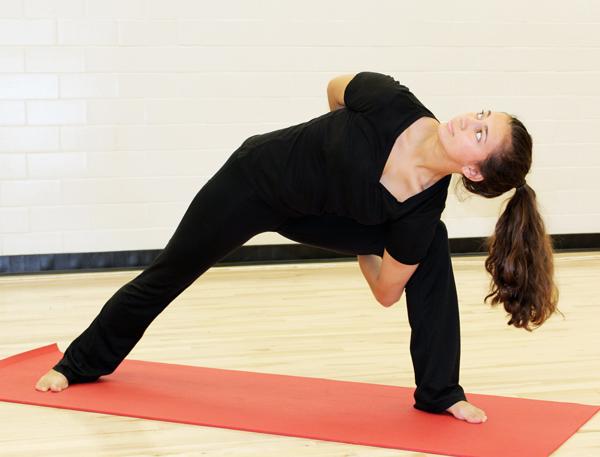
Alignment Cues:
- front heel intersects the arch of the back foot (“balance beam” feet)
- front knee and toe point straight ahead
- back knee and toe point directly sideways (90° out)
- hips and torso face 90° sideways
- stretching towards a 90° bend in the front knee
- pull top shoulder back, rotating the chest upwards towards the sky
- pull the sitting bones to point down towards the mat
Transition from Extended Side Angle: reach the top arm behind your lower back, reach the bottom arm under your front thigh, fingers join behind the front thigh
Drishti: upward, towards the sky
Strengthens: legs, oblique abdominals
Stretches: oblique abdominals, shoulders, chest
Baddha VirabhadrasanaHumble (Bound) Warrior
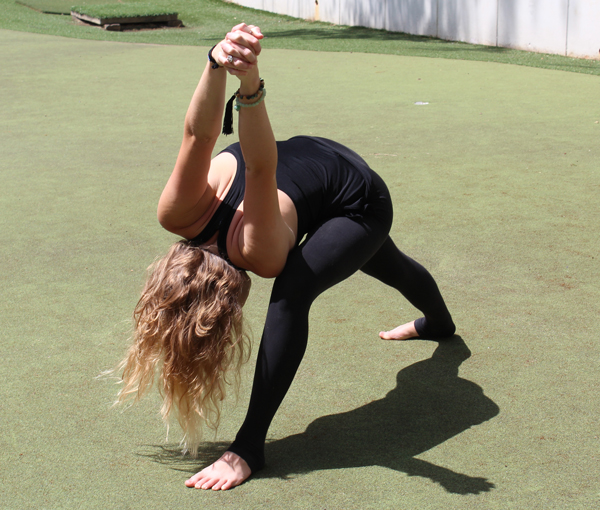
Alignment Cues:
- front foot, knee, hips, point forward
- back leg is rotated out (~45°)
- parallel leg alignment (“train track”) legs
- stretching towards a 90° bend in the front knee
- press strongly into the back foot (especially the outside edge)
- squeeze palms together and reach arms overhead towards the mat
- continue to reach through the top of the head and engage the abdominals to lengthen the spine
- pelvis tilts forward (anterior tilt) as the torso folds
Transition from Warrior I: interlace fingers behind the lower back, pull hands towards the back foot to open the chest, fold forward from the pelvisDrishti: gazing at the back foot or backwards through the legs (at the horizon behind you)
Strengthens: lower body
Stretches: shoulders
Indudalasana
Standing Crescent Pose (Moon Bends)
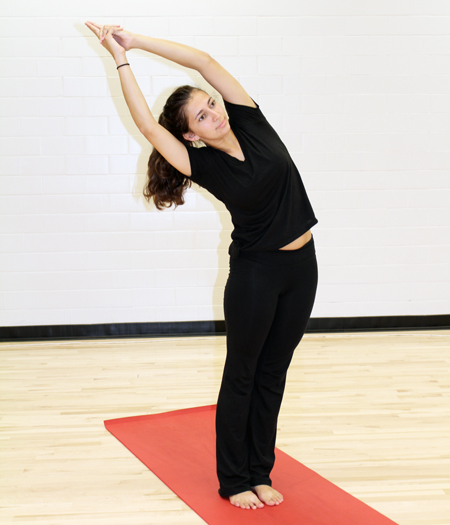
Alignment Cues:
- press firmly into both feet
- keep hips in line above the ankles (avoid shifting the hips sideways)
- shoulders drop away from the ears even as the arms are reaching overhead
- often performed with Jupiter mudra (as shown)
Transition from Tadasana: reach arms overhead into Jupiter mudra, reach the fingers up and over the the side, concentrate on the body getting longer even as you bend
Drishti: forward (gaze will follow the same arc as the torso)
Strengthens & Stretches: oblique abdominals
Malasana
Garland (Yoga Squat)

Alignment Cues:
- feet are slightly wider than hip-width apart
- legs are rotated out from the hip socket (~45° or less)
- be sure knees and toes point along the same diagonal
- often performed with anjali mudra (as shown)
- elbows can press the thighs open to increase the stretch in the hips
- keep chest upright
Drishti: straight forward or slightly down (back of the neck lengthened and the chin bowed towards the chest)
Stretches: Achilles tendons, adductors
Parighasasana
Gate Pose

Alignment Cues:
- press down through the top of the back foot to stabilize the posture
- reach up through the top arm even as you bend sideways
- be sure not to press into your knee with the bottom arm
Drishti: upward, looking under the bicep of the top arm
Strengthens & Stretches: oblique abdominals
Parsvottanasana
Pyramid (Intense Side Stretch)
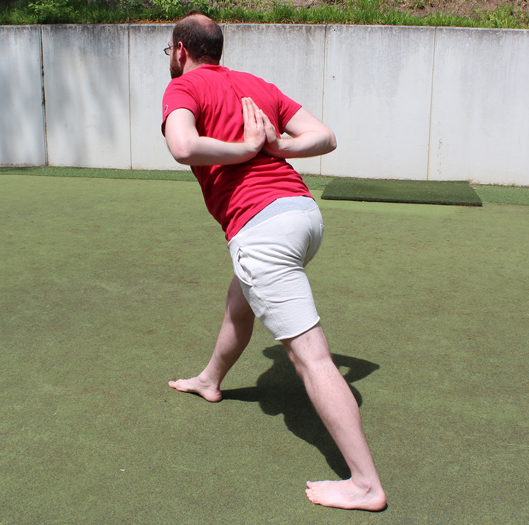
Alignment Cues:
- front foot, knee, hips point forward
- back leg is rotated out (~45°)
- each leg has its own lane (“train track”) legs
- press weight firmly into both legs
- fold from the hip crease with a long spine
- engage lower abdominals (uddiyana bandha, pulling in and up) to protect and lengthen the lower back
- often performed with arms in reverse prayer position (as shown)
Transition from Warrior I: straighten the front leg (moving the back foot closer to the front foot if necessary), bring arms behind the back, engage the lower abdominals, and fold forward only as far as possible while maintaining a long spine
Drishti: towards the floor or towards the shin of the front leg
Strengthens: back, abdominals, lower body
Stretches: hamstrings, shoulders (with reverse prayer mudra)
Prasarita Padottanasana
Wide Legged Forward Fold
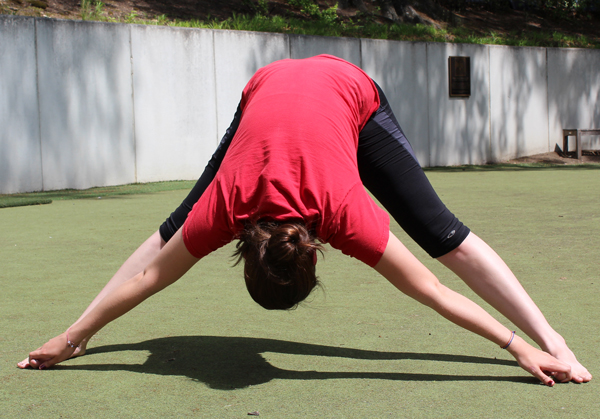
Alignment Cues:
- feet parallel to the edges of the mat
- press firmly into the outside edges of the feet and lift the arches
- engage the inner thighs as if the legs are pulling together
- multiple arm positions are possible in this posture (shown with big toe hold)
- relax/drape the head forward, forehead reaching towards the mat
Drishti: at the floor between and behind the legs
Strengthens: the lower body
Stretches: hamstrings
Tadasana
Mountain
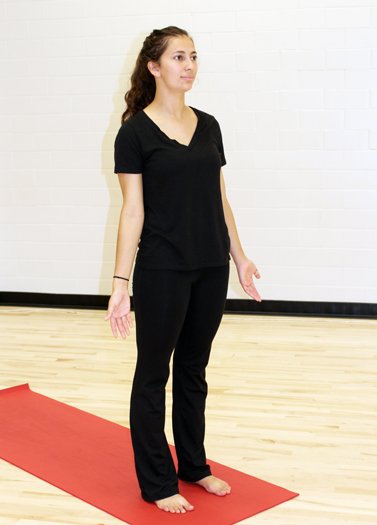
Alignment Cues:
- feet are parallel (point straight forward)
- feet can be together (traditional in Ashtanga practice) or slightly apart (heels lined up under sit bones)
- four corners of the feet press down (root) into the mat, arches lift
- quadriceps engage to lift the knees slightly forward and up (prevents “locking” the knees)
- neutral pelvis
- lower abdominals pulling in and up
- ribs relaxed, collar bones wide
- arms externally rotated
- shoulders slightly retracted and depressed
- top of the head floating/reaching upward
Drishti: straight forward
Trikonasana
Triangle

Alignment Cues:
- front heel intersects the arch of the back foot (“balance beam” feet)
- front knee and toe point straight ahead
- back knee and toe point directly sideways (90° out)
- hips and torso face 90° sideways
- keep both sides of the torso long as you reach the torso sideways
- torso stay in the same plane as the legs (do not bend forward, just sideways)
- engage lower abdominals (uddiyana bandha, pulling in and up) to protect and lengthen the lower back
- bottom arm may rest on the forward leg, on the floor, on a block, or it may hover off the floor (press sideways into the front shin if not pressing down)
- pull the top shoulder back to rotate the chest more upward
- pull up with the quadriceps of the front leg to avoid “locking out” the front knee
Transition from Warrior II: straighten the front leg, reach the torso forward, then lower the forward hand towards the floor and reach the top hand towards the sky, take the drishti upwards and pull the top shoulder back
Drishti: upward towards the top hand
Strengthens & Stretches: oblique abdominals, lower body
Utkatasana
Chair

Alignment Cues:
- feet are parallel (point straight forward)
- feet can be together (traditional in Ashtanga practice) or slightly apart (heels lined up under sit bones)
- be sure knees stay lined up over toes
- weight is mostly in the heels of the feet, toes can lift
- lower abdominals pulling in and up, tailbone dropping down
- a variety of arm positions can be performed with this posture
Drishti: Straight forward, slightly downward and forward, or upward (Ashtanga practice)
Strengthens: all lower body muscles around the thighs and hips
Utkata Konasana
Goddess
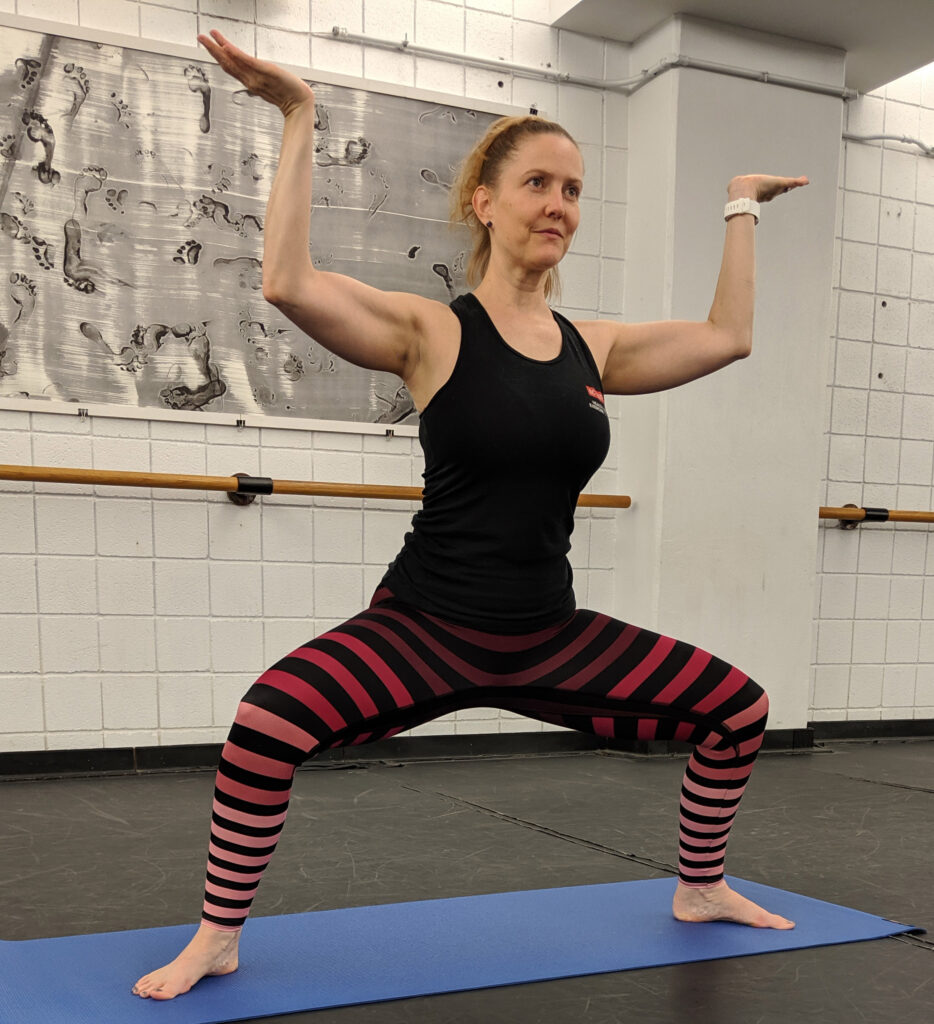
Alignment Cues:
- feet are wider than your hips and turned out, toes pointing on the diagonal
- be sure knees point in the same direction as your toes
- lower abdominals pulling in and up, tailbone dropping down
- a variety of arm positions can be performed with this posture
Drishti: Straight forward or slightly upward
Strengthens: quadriceps and inner thighs
Uttanasana
Standing Forward Fold
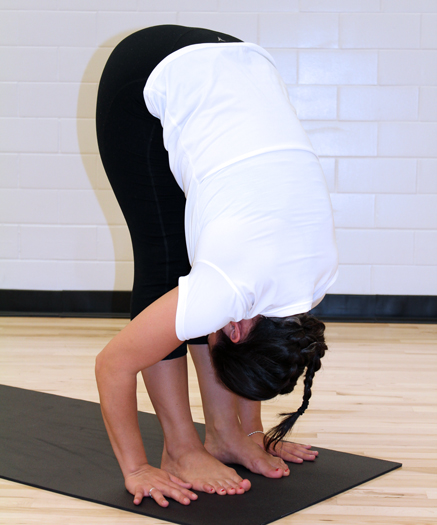
Alignment Cues:
- heels lined up directly under sitting bones
- feet pointing straight forward
- send weight into the balls of the feet to keep hips lined up over ankles (avoid “sitting back” in the hips)
- allow the head to relax and “hang” towards the floor
- the pelvis tilts forward (anterior tilt) as the torso folds
- sitting bones point behind you (NOT towards the mat)
Transition from Tadasana: hinge the torso forward from the hip crease
Drishti: where the inner heels meet the floor
Stretches: hamstrings
Utthita Ashva Sanchalasana
High Lunge
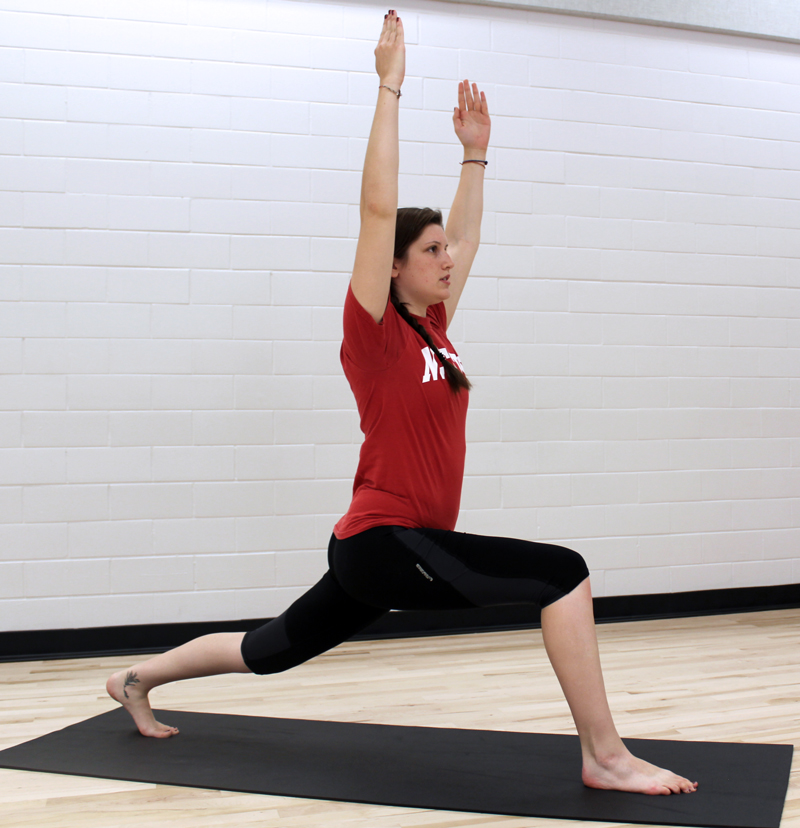
Alignment Cues:
- parallel leg alignment (“train track” legs)
- keep the front knee over the front ankle (do not allow it to travel forward)
- arms can reach overhead, rest on the front thigh, or take a variety of other positions
- engage lower abdominals (pulling in and up) to protect and lengthen the lumbar spine
Drishti: straight forward
Strengthens: lower body
Stretches: hip flexors of the back leg
Utthita Parsvakonasana
Extended Side Angle
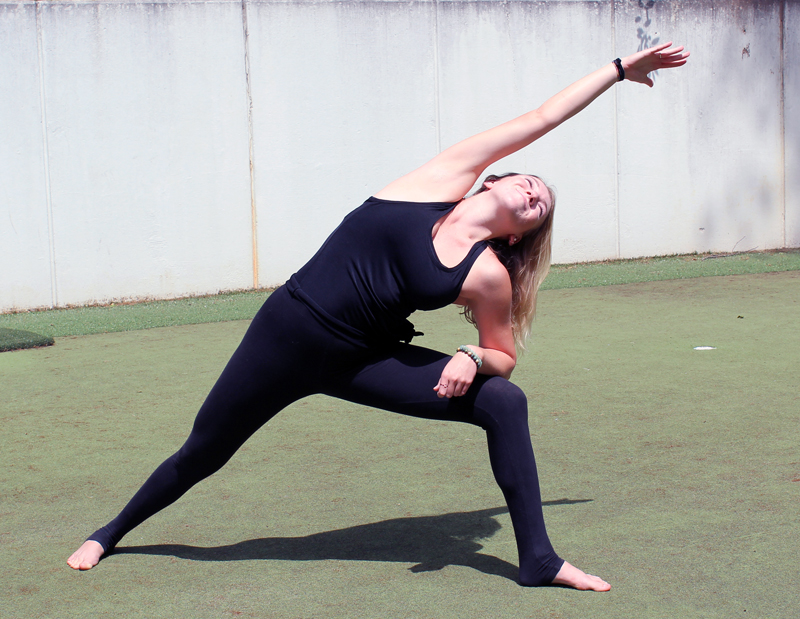
Alignment Cues:
- front heel intersects the arch of the back foot (“balance beam” feet)
- front knee and toe point straight ahead
- back knee and toe point directly sideways (90° out)
- hips and torso face 90° sideways
- stretching towards a 90° bend in the front knee
- reach the top arm diagonally up and forward, creating a straight line from wrist to ankle
- use the obliques to support the torso (do not drop weight into the bottom arm)
Transition from Warrior II: pull the front elbow to your thigh, reach the torso diagonally forward until it matches the angle of the back leg
Drishti: upward, looking under the bicep of the top arm
Strengthens: legs, oblique abdominals
Stretches: the entire side body
Viparita Virabhadrasana
Reverse Warrior
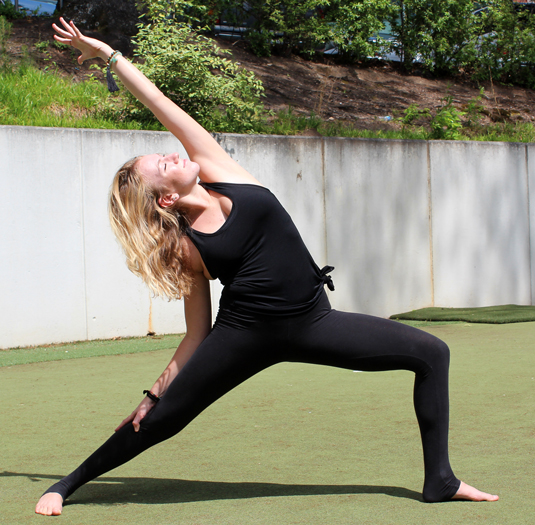
Alignment Cues:
- front heel intersects the arch of the back foot (“balance beam” feet)
- front knee and toe point straight ahead
- back knee and toe point directly sideways (90° out)
- hips and torso face 90° sideways
- stretching towards a 90° bend in the front knee
- back arm reaches down the back leg
- front arm reaches up and back, forming a side bend in the torso
- keep the top shoulder reaching down away from the ear
Transition from Warrior II: flip the front palm up, reach the front side of the torso up and towards the back
Drishti: up under the bicep of the top arm
Strengthens: legs
Stretches: oblique abdominals
Virabhadrasana I
Warrior 1
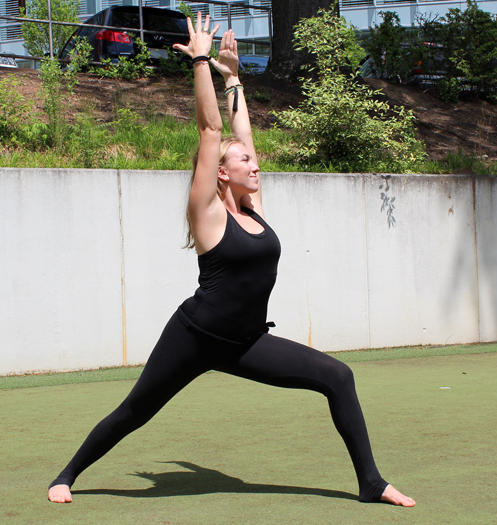
Alignment Cues:
- front foot, knee, hips, torso point forward
- back leg is rotated out (~45°)
- each leg has its own lane (“train track”) legs
- reach shoulders down away from ears
- engage lower abdominals (uddiyana bandha, pulling in and up) to protect and lengthen the lower back
- stretching towards a 90° bend in the front kneed
Drishti: straight forward
Strengthens: legs
Stretches: back calf and achilles
Virabhadrasana II
Warrior 2
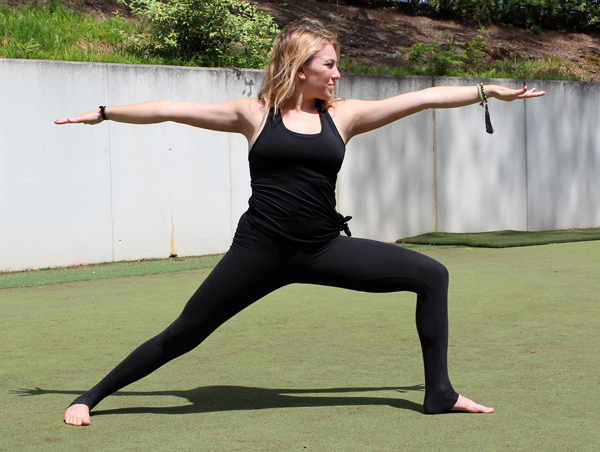
Alignment Cues:
- front heel intersects the arch of the back foot (“balance beam” feet)
- front knee and toe point straight ahead
- back knee and toe point directly sideways (90° out)
- hips and torso face 90° sideways
- shoulders centered directly over hips
- reach shoulders down away from ears
- engage lower abdominals (uddiyana bandha, pulling in and up) to protect and lengthen the lower back
- stretching towards a 90° bend in the front knee
- arms reaching as wide as possible
Drishti: straight forward, over the front middle finger
Strengthens: legs, arms, upper back